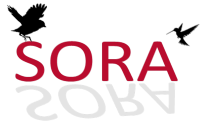Breeding of the Fork-Tailed Petrel Off the Washington Coast
Breeding of the Fork-tailed Petrel off the Washington Coast.-The fifth edition of the A.O.U. Check-list of North American Birds (1957) and Bent (U.S. Nat. Mus. Bull. 121, 1922:137), list the Fork-tailed Petrel (Oceanodroma fzcrcata) as breeding on islands off the coast of Washington. However, Jewett, Taylor, Shaw, and Aldrich (Birds of Washington State, 1953:74), and Dr. Alexander Wetmore in a personal communication, agree that this statement is based on a questionable egg record and that there is no authentic breeding record of this petrel for Washington, although there are good breeding records for sections of the coast to the north and the south. Consequently, it seems worth recording that on July 17, 1959, Garrett Eddy, William Hawkins, Karl Kenyon, and I discovered numerous burrows of Fork-tailed Petrels containing adults, young, and eggs, on Bodelteh Islands off Cape Alava, Clallam County, Washington.
The two main Bodelteh Islands, of approximately five and ten acres each, lie about a mile offshore and are part of the Flattery Rocks group. They have steep, rocky slopes, generally brush-covered and leading to somewhat level, wooded top areas over 190 feet high. The burrows of the petrels were usually two to four feet deep on steep, rocky, sparsely vegetated areas from 20 feet or so above high tide to over 150 feet. Typically they started in crevices or under rocks and continued, with some excavation of soft earth, to the nesting chamber. After finding the first two petrels, one on an egg and one on a newly hatched young, Eddy and I found some seven more occupied burrows in perhaps one hour’s additional search. Six of these held single young, up to about two weeks old, but no adults. Judging from our observations and those of Kenyon and Hawkins, the population of breeding Forktailed Petrels on Bodelteh Islands must consist of many hundreds of pairs.
Burrow-nesting species associated with the Fork-tailed Petrels on Bodelteh Islands were Leach Petrels (Oceanodroma Zeucorhoa) and Cassin Auklets (Ptychovamphus aleutica). Hawkins found four Leach Petrels on eggs in burrows on the brush and grass-covered south slope of the eastern island. The several occupied auklet burrows were all situated on fairly open areas beneath trees on the flattish tops of the islands above the slopes where the petrels were nesting. They held young, one of which was nearly fledged.
Evidence was seen of considerable predation, presumably by some mammal. Eight sets of wings and partial pectoral girdles of Fork-tailed Petrels were found under bushes in the course of a limited search. The difficulty of landing on Bodelteh makes it seem unlikely that predators such as domestic rats have been introduced to the islands, so it is hoped a native predator is involved and something of a balance has already been reached between it and the population of the Fork-tailed Petrel.- FRANK RICHARDSON, Department of Zoology and Washington State Museum, University of Washington, Seattle, September 29, 1959.

